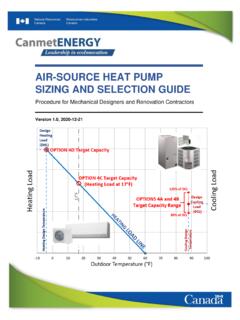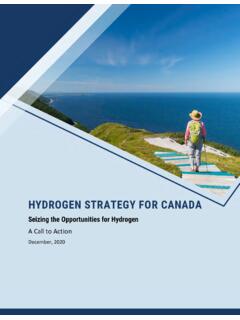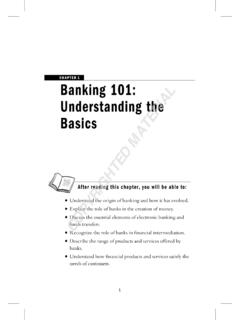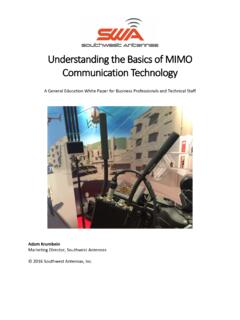Transcription of Topographic Maps: The basics - NRCan
1 Topographic Maps: The basicsTopographic maps produced by Natural Resources Canada ( NRCan ) offer detailed information on a particular area and are used for several types of activities such as emergency preparedness, urban planning, resource development and surveying to camping, canoeing, adventure racing, hunting and guide will help the user understand the basics of Topographic maps. The guide provides an overview of mapping concepts, along with tips on how to use a Topographic map, explanations of technical terminology and examples of symbols used to represent Topographic features on Topographic Topographic maps represent the Earth s features accurately and to scale on a two-dimensional surface. Topographic maps are an excellent planning tool and guide and, at the same time, help make outdoor adventures enjoyable and is a Topographic map?
2 A Topographic map is a detailed and accurate illustration of man-made and natural features on the ground such as roads, railways, power transmission lines, contours, elevations, rivers, lakes and geographical Topographic map is a two-dimensional representation of the Earth s three-dimensional landscape. The most frequently used Canadian Topographic map is at the scale of 1:50 information is on a Topographic map? Topographic maps identify numerous ground features, which can be grouped into the following categories:Relief: mountains, valleys, slopes, depressions as defined by contours Hydrography: lakes, rivers, streams, swamps, rapids, falls Vegetation: wooded areasTransportation: roads, trails, railways, bridges, airports/airfield, seaplane anchoragesCulture: buildings, urban development, power transmission line , pipelines, towers Boundaries: international, provincial/territorial, administrative, recreational, geographicalToponymy: place names, water feature names, landform names, boundary namesRefer to the map legend for a complete listing of all features and their corresponding symbols.
3 Information along the map borders provides valuable details to help you understand and use a Topographic map. For example, here you will find the map scale and other important information about the map such as the year, the edition and information pertaining to the map data. Topo tip: A legend explaining the symbols can be viewed atthe side of some maps or obtained fromyour map dealer. Symbol information can also be obtained Review the map data and publication date locatedon the bottom left corner of the map. 2 Topographic MAPS: The basicsTopo tip: Use contour lines to determine elevations ofmountains and flat areas. The closer togetherthe lines are, the steeper the slope. Contour elevation numbers indicate thedirection of elevation by always reading(pointing) is scale?
4 Maps are made to scale. In each case, the scale represents the ratio of a distance on the map to the actual distance on the ground. A standard Canadian Topographic map is produced at 1:50 000, where 2 cm on the map represents 1 km on the maps ( 1:50 000) cover smaller areas in greater detail, whereas small-scale maps ( 1:250 000) cover large areas in less detail. A 1:250 000 scale national Topographic system (NTS) map covers the same area as sixteen 1:50 000 scale NTS a Topographic map similar to a road map?Both types of maps show roads, water features, cities and parks, but that s where the similarity ends. Topographic maps show contours, elevation, forest cover, marsh, pipelines, power transmission lines, buildings and various types of boundary lines such as international, provincial and administrative, and many maps show a universal transverse mercator (UTM) grid, allowing the user to determine precise positions.
5 In basic terms, Topographic maps allow the user to see a three-dimensional landscape on a two-dimensional do the colours mean?A variety of colours can be found on a map, each relating to different types of features. Black shows cultural features such as buildings, railways and power transmission lines. It is also used to show geographical names (toponymy), certain symbols, geographic coordinates and precise represents water features, such as lakes, rivers, falls, rapids, swamps and marshes. The names of water bodies and water courses are also shown in blue, as are magnetic declination and UTM grid indicates vegetation such as wooded areas, orchards and northern areas of Canada are mapped in black and white (monochrome).What are contour lines?
6 Contour lines connect a series of points of equal elevation and are used to illustrate relief on a map. They show the height of ground above mean sea level (MSL) either in metres or feet, and can be drawn at any desired interval. For example, numerous contour lines that are close to one another indicate hilly or mountainous terrain; when further apart they indicate a gentler slope; and when far apart they indicate flat terrain. 3 Topographic MAPS: The basicsTopo tip: Know what map scale you re using to measure distance. Refer to the scale bar at the bottom of the do I measure distance on a map?Use the scale bar found at the bottom of every NRCan Topographic map to determine distances between points or along lines on the map sheet. Use the secondary division on the left of the scale bar for measuring fractions of a is a grid?
7 A grid is a regular pattern of parallel lines intersecting at right angles and forming squares; it is used to identify precise positions. To help you locate your position accurately on the surface of the Earth (or map sheet), Topographic maps have two kinds of referencing systems: universal transverse mercator (UTM) projection (easting/northing) geographic: degrees and minutes (longitude/latitude)The projection used for Topographic maps is UTM grid is a square grid system of lines depicted on maps and based on the transverse mercator projection. It can be used to accurately locate the position of features on the map by distance or direction. To express your location in grid coordinates or geographic coordinates, read the following can I find or express a location on a map?
8 You can find or express a location on a map by using geographic coordinates (longitude, latitude) or by using UTM grid coordinates (easting, northing).Geographic coordinates are expressed in degrees, minutes and seconds and can be determined on the map by using the longitude and latitude graticules placed along the edges of the map. Latitude graticules are placed along the east and west edges of the map and longitude graticules are placed along the north and south edges of the map. The longitude and latitude of your location can be determined by projecting your location to the map edges and then by reading the corresponding latitude and longitude grid coordinates are expressed in metres and can be determined on the map by using the UTM grid lines.
9 These grid lines are equally spaced horizontal and vertical lines superimposed over the entire map. The coordinate value for each grid line can be found along the edge of the map. Northing values can be read along the east or west edges of the map and easting values can be read along the north or south edges of the map. The easting and northing of your location can be determined by projecting your location to the nearest horizontal and vertical grid lines and then reading the corresponding easting and northing MAPS: The basicsAs an example, the position of the sportsplex located in the top right corner of 92-G/3 Lulu Island of British Columbia is located in UTM Zone 10 and the coordinates are and The same position can also be described using geographic coordinates 123 01'E longitude, 49 14'N tip: Determine your easting first, and then find yournorthing.
10 (In the house, then up the stairs.)How do I find a grid reference?To find the map reference of a feature located at 984531 on a 1:50 000 scale Topographic map,Determine the easting: Read the grid line value left of the feature: 98. Estimate tenths of a square to the right (eastward)to feature: 4. Your easting is the northing: Read the grid line value below the feature: 53. Estimate tenths of a square up (northward) to thefeature: 1. Your northing is 531. The map reference for this feature is tip: Use a roamer to help locate features (see theillustation at left). Always measure over to the east and then up tothe north. In other words, find the easting, thenthe can I determine where I am on a map using a GPS receiver?If you have a GPS receiver, your location can be determined very quickly.
















